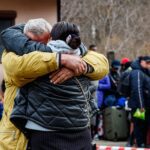Background: The United Nations reported that in 2016 over 65 million people worldwide have forcibly left home. Over 50% are children and adolescents; a substantial number has been traumatized and displaced by war. Objective: To provide an overview of the effectiveness of psychosocial interventions in this group we conducted a narrative review and a meta-analysis of intervention studies providing data on posttraumatic stress symptoms (PTSS), depression, anxiety, grief, and general distress. Method: We searched PILOTS, MEDLINE, WoS, Embase, CENTRAL, LILACS, PsycINFO, ASSIA, CSA, and SA for studies on treatment outcomes for war-traumatized displaced children and adolescents. Between-group effect sizes (ES) and pre-post ES were reconstructed for each trial. Overall pre-post ES were calculated using a random effects model. Results: The narrative review covers 23 studies with a variety of treatments. Out of the 35 calculated between-group ES, only six were significant, all compared to untreated controls. Two of them indicated significant adverse effects on symptoms of general distress or depression. When calculating pre-post effect sizes, the positive between-group results of cognitive behavioural therapy (CBT) and interpersonal therapy (IPT) were reproduced and singular other treatments showed significant positive effects. However, the mean pre-post effects for PTSS and depression could not be interpreted due to the high heterogeneity of the included studies (PTSS: ES = 0.78; I2 = 88.6%; depression: ES = 0.35; I2 = 93.1%). Only the mean pre-post effect for seven active CBT treatment groups for depression (ES = 0.30, 95% CI [0.18, 0.43]) was interpretable (Q = 3.3, df = 6, p = .77). Conclusion: Given the large number of children and adolescents displaced by war there were regrettably few treatment studies available, and many of them were of low methodological quality. The effect sizes lagged behind the effects observed in traumatized minors in general, and often were small or non-significant. However, CBT and IPT showed promising results that need further replication.
Diversity initiatives in the US workplace: A brief history, their intended and unintended consequences
Diversity initiatives are designed to help workers from disadvantaged backgrounds achieve equitable opportunities and outcomes in organizations. However, these programs are often ineffective. To better

